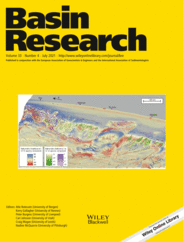
Full text loading...
 , Genhou Wang1, Jinhan Gao1, Haishui Jiang3, Guoli Yuan1, Dian Li4, Wentao Cao2,5
, Genhou Wang1, Jinhan Gao1, Haishui Jiang3, Guoli Yuan1, Dian Li4, Wentao Cao2,5 , Yilong Zheng1, Qiang Fang1, Byung‐Su Lee6, Soo‐In Park6, Yaxi Wang1, Jia Zhao1
, Yilong Zheng1, Qiang Fang1, Byung‐Su Lee6, Soo‐In Park6, Yaxi Wang1, Jia Zhao1
The late Permian–Triassic trench‐slope basin in the CQMB showing the correlation between spatiotemporal variations in basin sedimentation and the extensional tectonism of the accretionary wedge.
Records of sedimentation and deformation in trench‐slope basins contain valuable tectonic information about the associated oceanic subduction zone. Here, we present a multidisciplinary study on newly discovered late Permian–Triassic sedimentary successions in the >500‐km‐long Central Qiangtang metamorphic belt (CQMB) to better understand the type of basin and the concomitant tectonism. The Mayer Kangri succession contains lithofacies associations of submarine fan siliciclastic rocks, slope‐environment limestone, deep marine chert and minor olistostromes from the forearc basin. The conodont assemblages and sandstone and andesite interlayers yield continuous stratigraphic ages from the Lopingian to middle Norian. The clastic sediments had two provenances, including the epicontinental arc in the North Qiangtang block (NQB) and synchronous volcanism in the accretionary wedge. Moreover, a large suite of the Anisian–early Carnian radiolarian cherts (>30 m thick) was discovered in the Lanling area. Regionally, the CQMB shows evident spatiotemporal variations in late Permian–Triassic sedimentation, with a general depositional trend of southward deepening and getting younger. The three identified subzones include a bathyal setting, a carbonate platform setting and a deep marine setting from north to south. These observations indicate that the late Permian–Triassic sedimentary successions in the CQMB were deposited in a trench‐slope basin environment during the northward subduction of the Longmu Co–Shuanghu Tethys Ocean beneath the NQB. Generally, the CQMB and the concomitant trench‐slope basin is among the well‐preserved ancient analogs characterized by extensional tectonism. The syndepositional horst‐graben‐like structure, forearc basin‐derived olistostromes, abyssal radiolarian cherts and synchronous volcanism provide new implications for the geological evolution of the trench‐slope basin.
]
Article metrics loading...

Full text loading...
References


Data & Media loading...

